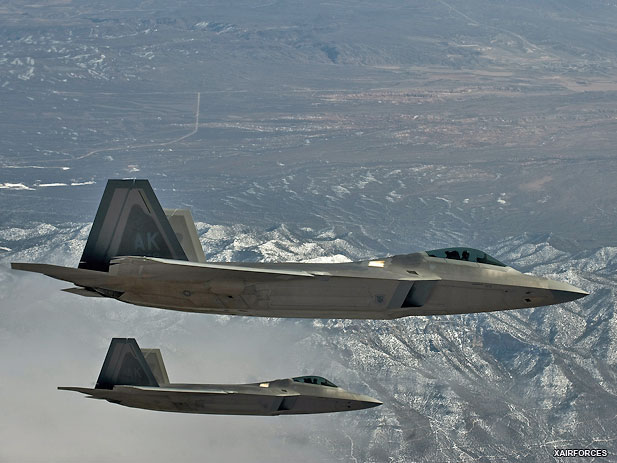
Problem Unsolved, F-22s to Return to Flight: Sources

The U.S. Air Force is planning to lift the four-month grounding of its F-22 Raptor fleet, although it has yet to figure out what went wrong in the aircraft's oxygen system, sources said.
Service officials will meet Friday to determine what restrictions will remain on the planes, the culmination of a lively debate between various factions in the Raptor community, sources said.
The service grounded the twin-engine fifth-generation fighter on May 3 after pilots reported 14 incidents of "hypoxia-like" symptoms. According to one former F-22 pilot, toxic chemicals were found in the bloodstreams of the affected aviators.
Investigators have yet to ascertain the cause of the problem with the Raptors' On-Board Oxygen Generating System (OBOGS).
"They haven't pinpointed it," one source said. "But they feel that the risk is mitigated enough to stop the grounding while they continue to see what can be done to solve the problem."
Idled F-22 pilots have been working hard in simulators and training aircraft, but their skills have atrophied during their months-long exile from their cockpits.
The service is also responding to media coverage of the grounding, which has prevented the planes, among other things, from participating in the NATO campaign against Libyan government forces.
"Mainly, they have pressure to fly the jet to stop the bad press about the $100-plus- million static displays," the source said.
In a recent interview with Air Force Magazine, Air Force chief of staff Gen. Norton Schwartz said that the F-22 would be flying soon. Schwartz also said he expects a report next week from his service's Scientific Advisory Board, which has been investigating the OBOGS problem. That report will help determine the service's course of action.
"This report, in conjunction with the results of ongoing safety investigation and recent flight tests, will provide in-depth technical analysis, data, and recommendations for improved flight operations," Lt. Col. Sam Highley, a spokesman for Schwartz, said in an email to Defense News. "While the Air Force continues to work diligently toward an expedient return to flight operations, the stand-down of the F-22 fleet will continue until senior leadership can ensure we mitigate risks to a level that's appropriate for the urgency of the mission."
Highley also confirmed that the recent waiver granted to the 1st Fighter Wing to escape a recent hurricane was a dress rehearsal for when the F-22s return normal operations.
Once the Raptors return to flight, the service will likely require the jets to be moved from their hangars before their engines are started. An indoor buildup of carbon monoxide from the jets' exhaust may have contributed to the problems.
That would give the Air Force some remaining warm weeks or months "to get to the real problem solved and figure out proper hangar operations" before cold weather makes such operations more inconvenient, the source said.
Sources said the oxygen system problem may be a valve that is failing to keep toxins out of the system's zeolyte beds, which help draw oxygen from the ambient air, sources said.
"The hangar and that valve introduce too many contaminants," one source said.
There is also a debate as to what post-grounding restrictions the jets will face. Some in the test community would like to restrict the F-22 to altitudes of 40,000 feet, but members of the operational community want to resume flying the aircraft's full flight envelope at up to 60,000 feet.
"Operational physiology doesn't support that restriction and it should be cleared for the full envelope because it would take a dual engine flameout coupled with a rapid decompression on a Raptor that has an OBOGS that isn't performing nominally," one source said. "The pilot would know this event occurred and would have proper emergency procedures that mean they pull the green ring [emergency oxygen supply] and descend."
Air Force physiologists say pilots would have mere seconds to react if such a case were to happen.
But the operational pilot community argues that the physiologists' methods don't reflect the real-life circumstances that aviators face in the cockpit and fail to take into account pressure breathing apparatus.
"The pilot would have been getting air with much more oxygen percentage and would continue to get air by pulling the green ring so that the Time of Useful Consciousness chart in physiology does not apply to this case," one source said. "The bro network is going full force to get the aircraft cleared to 60,000 feet."
Source: By DAVE MAJUMDAR - www.defensenews.com (Published: 31 Aug 2011)
Photo: U.S. Air Force F-22 Raptors fly over the Nevada Test and Training Range in March. The Air Force plans to lift the four-month grounding of the Raptor fleet, according to sources. (Senior Airman Brett Clashman / Air Force)
(31.08.2011)
|